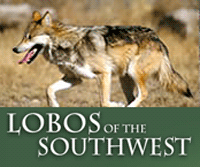The Arizona Republic (Original) Posted June 15, 2023 Op-Ed by EJ Montini
Opinion: Humans could learn some things from a fervent nomad who refuses to respect boundaries.
The boundaries are clearly defined.
Asha the Mexican gray wolf simply ignored them.
It’s right there in black and white.
The U.S. Fish and Wildlife Service, by way of the Mexican Wolf Experimental Population Area, says that gray wolves are free to wander in a geographic area that encompasses Arizona and New Mexico from Interstate 40 south to the international border with Mexico.
It’s a pretty big playground, don’t you think?
But, nooo.
Wolf was not where she's 'supposed' to be
Asha the wolf, who began her free life in Arizona, got picked up in January by Fish and Wildlife officers well east and almost 150 miles north of Interstate 40, near Taos, New Mexico, a magical place that for generations has drawn artists, visionaries and iconoclasts.
As well as at least one headstrong, adventurous wolf.
And who could blame her? The Sangre de Cristo mountains are there. The Rio Grande Gorge. The light. The landscape. The expanse. It is a place for dreamers.
The artist Georgia O’Keefe lived there. And for a time, the writer D.H. Lawrence.
The American frontiersman Kit Carson spent time in Taos. It was fancied, and still is fancied, by artists, actors, scientists and free thinkers from all over the world.
Asha is out of lobo jail, for now
Asha got nabbed not far from there and wound up in New Mexico’s Sevilleta Wolf Management Facility.
Lobo lockup.
In that place she was known as f2754 (just as human inmates go by numbers.)
This week, Fish and Wildlife announced that Asha had finished serving her time and had been returned to the wilds of Arizona.
In a press release issued by several conservation organizations, Sandy Bahr, director of Sierra Club’s Grand Canyon Chapter, said, “We’re excited that Asha is back in the wild, where she belongs.
“Asha was captured and put into captivity for merely doing what wild wolves do — wandering over large distances. She was doing her part for wolf recovery, we need the agencies to do theirs and to let these animals disperse.”
She's not truly free. There's a lesson in that
There was a time when wolves like Asha roamed anywhere and everywhere in the West.
They disappeared because of a powerful livestock lobby, hysteria among humans and a government approved hunting program that wiped out Mexican gray wolves in the lower 48 states by the 1950s.
The wolves were reintroduced to Arizona and New Mexico in 1998.
But it came with limitations. Boundaries.
Cyndi Tuell, Arizona and New Mexico director of Western Watersheds Project, said in a press release, “Asha is a courageous young wolf, and we’re thrilled she’s once again free to continue living her life on her own terms.”
Not exactly.
If Asha were living on her own terms she’d be free to go anywhere, to explore, to drift between mountain clouds and desert sunrises, to follow the scent of a deer no matter where it led her, to end up, if she chose, in Taos, where D.H. Lawrence said “a new part of the soul woke up suddenly, and the old world gave way to new.”
That would be freedom. And not just for her.
In the end, what we learn from a fervent nomad like Asha is that it’s not wolves who must learn about boundaries, or the lack of them, but us.
Reach Montini at This email address is being protected from spambots. You need JavaScript enabled to view it..





